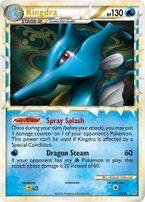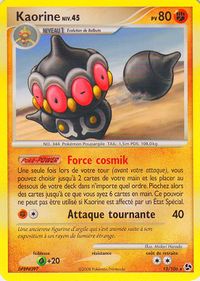Kingdra archetype (TCG)
| Kingdra | ||||||||||
|---|---|---|---|---|---|---|---|---|---|---|
| ||||||||||
Although the Kingdra archetype went through numerous variations since Kingdra was released in the Legends Awakened expansion, decks based around it were a staple in the metagame since 2008. The deck won a number of major tournaments. Although it fell out of favor with players in late 2009, the deck underwent a revival with the release of Kingdra Prime in Unleashed and won approximately twenty 2010 Spring Battle Roads in the United States. Kingdra had a far more straightforward strategy than most decks in that it was based solely on taking six prizes quickly by attacking with low-energy, moderately damaging attacks. This strategy lent itself to a strong, fast drawing engine such as Claydol and suffered from few bad matchups. The deck dropped considerably in popularity after the 2010 rotation, due to Claydol's unplayability in Play! Pokémon events.
Strategy
Unlike many decks that have a designated "ideal start," the Kingdra archetype focused simply attacking right away rather than setting up behind a starting Pokémon. For this reason, although starting with Horsea was preferred, the deck did not suffer from bad starts (with the possible exception of Uxie) due to its use of Unown Q.
Regardless of what Pokémon the player started with, it was important to get as many Kingdra Prime, Kingdra, and Claydol on the field as possible early in the game. This way, the deck had a better chance of simply overrunning the opponent before they could set up well. Kingdra's setup could be achieved by utilizing strong drawing and searching Supporter cards such as Professor Oak's New Theory and Bebe's Search, respectively, along with fast Trainers such as Pokémon Communication and Poké Drawer +. Once one Claydol hit the field, the deck's setup was much easier as it had the ability to draw a number of cards each turn. Thus, many players chose to expend resources to get Claydol out before Kingdra or Kingdra Prime. Rare Candy and especially Broken Time-Space were essential to the deck's setup since they sped up the evolution process, resulting in more Kingdra and more Claydol on the field faster.
After the player had multiple Kingdra or Kingdra Prime on the field as well as Claydol, there was little to do but continuously attack and make sure the player had the resources in hand to recover fallen Kingdra, such as Palmer's Contribution. The Kingdra archetype benefited from its ability to damage the opponent's bench, both through Kingdra's Dragon Pump attack and Kingdra Prime's Spray Splash Poké-Power. Although the damage was not much initially (20 damage for Dragon Pump and 10 for Spray Splash), it could add up quickly and result in extra, unexpected knockouts.
Key Cards
- Kingdra Prime - Kingdra Prime could attack for 60 damage for only
 with Dragon Steam. Spray Splash, Kingdra's Poké-Power, allowed the Kingdra player to place 10 damage on one of the opponent's Pokémon once per turn. Spray Splash was stackable, meaning that the Kingdra player could use it multiple times per turn if he or she had multiple Kingdra Prime on the field.
with Dragon Steam. Spray Splash, Kingdra's Poké-Power, allowed the Kingdra player to place 10 damage on one of the opponent's Pokémon once per turn. Spray Splash was stackable, meaning that the Kingdra player could use it multiple times per turn if he or she had multiple Kingdra Prime on the field. - Kingdra - The Kingdra from Legends Awakened was a stronger attacker than Kingdra Prime, but lacked the important Spray Splash power. Although it was generally a useful attacker, it shone against Fire-type Pokémon. Whereas Kingdra Prime's Dragon Steam did only 20 damage if the opponent had a Fire-type in play, this Kingdra did 60 damage regardless and 20 a Benched Pokémon with Dragon Pump. Kingdra's second attack, Aqua Stream provided an additional threat late in the game. Aqua Stream did 10 damage for each
 Energy card in the player's discard pile for
Energy card in the player's discard pile for  . Then, those Energy cards were shuffled back into the player's deck. Since this list runs 8
. Then, those Energy cards were shuffled back into the player's deck. Since this list runs 8  energy, Aqua Stream maxes out at 80 damage without an Expert Belt.
energy, Aqua Stream maxes out at 80 damage without an Expert Belt. - Claydol - Claydol was the deck's primary drawing engine. Since Kingdra's Dragon Pump required a two-card discard from the hand for maximum effect, it was vitally important to maintain a large hand. Additionally, Claydol provided a way to get many Kingdra and Kingdra Prime out early in the game, simply by giving the player access to more cards.
- Ditto - Although it cannot really be considered an essential part of the deck's core strategy, Ditto provided an inexpensive and often unforeseen way to retaliate after a knocked out Kingdra in the LuxPluff and Mother Gengar matchups, as well as the mirror match. Multi Energy allowed Ditto to utilize any opposing Pokémon's attack, provided it cost only one energy.
- Broken Time-Space - Since the deck was based around evolutions, Broken Time-Space was critical to getting Pokémon up and running quickly by allowing the player to bypass the typical one-turn waiting period on evolving.
- Rare Candy - Much like Broken Time-Space, Rare Candy was very useful for getting Kingdra up and ready to attack as quickly as possible. Rare Candy allowed Kingdra to keep pace with the decks that were popular during the format in which Kingdra was used, such as LuxChomp (TCG)
Typical decklist
The deck list appearing below is not official; it is meant to represent an average build of the archetype, not specifically constructed for any regional metagame. Being that this is merely an archetype, a player may wish to change any part of this deck when building his or her own version.
| Quantity | Card | Type | Rarity |
|---|---|---|---|
| 2× | Kingdra Prime | ||
| 2× | Kingdra | ||
| 3× | Seadra | ||
| 4× | Horsea | ||
| 3× | Claydol | ||
| 3× | Baltoy | ||
| 1× | Uxie | ||
| 1× | Ditto | ||
| 1× | Unown Q | ||
| 4× | Bebe's Search | Su | |
| 3× | Pokémon Collector | Su | |
| 1× | Roseanne's Research | Su | |
| 2× | Professor Oak's New Theory | Su | |
| 1× | Palmer's Contribution | Su | |
| 3× | Pokémon Communication | T | |
| 3× | Rare Candy | T | |
| 2× | Expert Belt | T | |
| 1× | Luxury Ball | T | |
| 4× | Poké Drawer + | T | |
| 3× | Broken Time-Space | St | |
| 4× | Multi Energy | ||
| 8× | Water Energy | — | |
Possible Tech Cards
- Regice - With its Regi Move Poké-Power, Regice could be potentially devastating to decks based around Basic Pokémon. It was especially effective since Kingdra was used in a format dominated by Pokémon SP. It also caused significant disruption to decks with a designated Basic starting Pokémon, such as Sableye in Sablelock and Spiritomb in a variety of decks.
- Manectric - Manectric prevented the opponent from attacking Claydol, the deck's main drawing support, with attacks such as Garchomp C LV.X's Dragon Rush. Considering the popularity of cards like Garchomp C LV.X and Honchkrow G during Kingdra's era, Manectric was a popular tech. Additionally, with the use of Multi Energy in the deck, Manectric could provide a secondary attacker against Poké-Power heavy decks.
- Machamp - Machamp was used in some Kingdra variants for its Take Out attack, which automatically knocked out the opponent's active Basic Pokémon for only
 . This was possible through Multi Energy and especially effective against decks based around Pokémon SP.
. This was possible through Multi Energy and especially effective against decks based around Pokémon SP.



